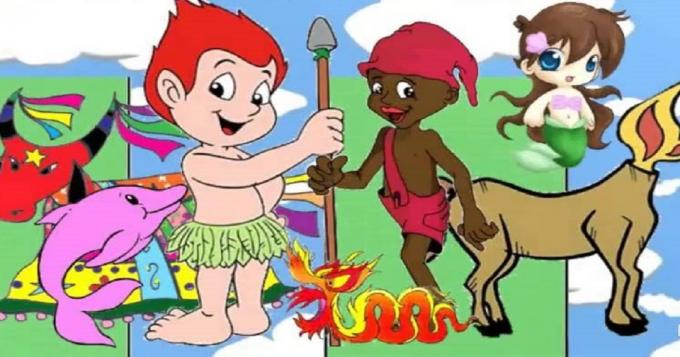
What is folklore? Folklore is a set of MYTHS and LEGENDS that are part of our culture and that are passed from generation to generation.
The myths are born from the imagination of people, mainly in the interior of Brazil.
Many of these stories were invented to get messages across, or just to scare or amuse people.
Folklore is divided into: Legends, Myths, Songs, Popular festivals, riddles, proverbs etc.
Index
Also check: Folklore songs.
the boto
Victoria Regia
Curupira or Caipora
Mapinguari
Boitatá
Saci-Pererê
The Origin of Pirarucu
The Origin of the Manatee
Capelobo
Headless mule
werewolf
The Origin of Cassava
One-armed jaguar
Ox-Jaguar
the origin of the moon
The Origin of Guarana
Iara
Cuca - The Origin of the Sun
the devil in the bottle
Snake -Honorate
Mattita Perêra
bogeyman
head
Werewolf
Boggart
Saci-Pererê
Headless mule
the devil in the bottle
the blue jay
O Negrinho do Pastoreio
procession of souls
hairy hand
Caipora and Curupira
Rufous Hornero
Bottle foot
Myths are narratives that have a strong symbolic component. As the peoples of antiquity could not explain the phenomena of nature, through scientific explanations, they created myths with this objective: to make sense of the things of the world. The myths also served as a way to pass on knowledge and alert people about dangers or defects and qualities of the human being. Gods, heroes and supernatural characters mix with facts of reality to give meaning to life and the world.

Also check outLegends of Brazil told by the Folklore Gang.
The legend of the boitatá was created by the priest José de Anchieta, where he described the boitatá as a gigantic wavy fire copper, with eyes that look like two headlights, transparent leather, that sparkles on the nights it appears gliding across meadows and riverbanks
The curupira lets out high-pitched whistles to frighten and confuse hunters and woodcutters, in addition to creating illusions, until the criminals get lost or go mad in the middle of the forest. Its back-turned feet serve to throw off the hunters, who, as they go after the footprints, go in the direction.
Curupira is a protector of forests and wild animals. Represented by a dwarf with long hair and feet turned backwards. Chases and kills all who disrespect nature. When someone disappears into the woods, many inhabitants of the interior believe that it is the work of the curupira.
In the Amazon, there is the legend of the dog tapir, a huge animal that has the shape of a jaguar and paws with a tapir's hoof. If you're chasing someone who climbs a tree, the animal digs in the earth until the tree in which your enemies take refuge falls.
Saci Pererê is one of the best known characters in Brazilian folklore. It even has a day in its honor: October 31st. It probably arose among indigenous peoples in the southern region of Brazil
Also known as the mother of waters, Iara is a character in Brazilian folklore. According to the legend, of indigenous origin, Iara is a mermaid (a woman's body from the waist up and a fish from the waist down) brunette with black hair and brown eyes.
Riding a wild pig, the caipora walks naked through the forest and dominates all the animals. According to legend, he attacks hunters who do not comply with hunting agreements made with him. Like the curupira, with whom he is related, his mission is to protect the animals of the forest.
The werewolf is one of the best known fictional monsters in the world. Its origins are found in Greek mythology, but its history developed in Europe. The werewolf legend is well known in Brazilian folklore, and some people, especially those who are older and who live in rural areas, actually believe in the existence of the monster.
This myth appears in various regions of the world. The myth says that a man was attacked by a wolf on a full moon night and did not die, but he developed the ability to transform into a wolf on a full moon night. On these nights, the werewolf attacks everyone he encounters. Only a silver bullet shot through his heart could kill him.
The headless mule is literally a headless mule, which releases fire through its neck, where its head should be. Its hooves have horseshoes that are silver or steel and have a brown or black color.
Legend has it that the Moon was a god who dated the most beautiful Indian girls and whenever he hid, chosen and took some girls with him. In an indigenous village, there was a beautiful young woman, the warrior Naiá, who dreamed of the Moon and couldn't wait for the day when the god would call her.
According to the legend, a pink dolphin comes out of the rivers on June party nights, and manages to transform itself into a beautiful young man dressed in white social clothes. With its flirtatious and talkative manner, the boto approaches the unaccompanied young women, seducing them. Soon after, she manages to convince the women to take a walk at the bottom of the river, where she usually gets them pregnant. The next morning it turns into a botde again.
Negrinho do Pastoreio is an Afro-Christian legend. Much told in the late nineteenth century by Brazilians who defended the end of slavery. It is very popular in the southern region of Brazil. The legend is very well described by Simões Lopes Neto, in his book Contos Gauchescos & Lendas do Sul. In Uruguay, the legend is also known as `El Negrito del pastoreo´´.
Chupa-Goat is a supposed creature responsible for systematic attacks on rural animals in regions of America such as Puerto Rico, Florida, Nicaragua, Chile, Mexico and Brazil. The creature's name comes from the discovery of several dead goats in Puerto Rico with bite marks on their necks and their allegedly drained blood.
Macunaíma was born in an Amazonian tribe. He spends his childhood there, but he is not a child like the others in the place. He is a lying boy, a traitor, he practices a lot of naughty things, speaks a lot of bad words, besides being extremely lazy. He has two brothers, Maanape and Jiquê.
It is one of the oldest in Colonial Brazil. Anhangá brings to the one who sees it, hears it or senses a certain harbinger of misfortune. The places known to be frequented by him are haunted. It has many forms, both human and animal. But the figure with which the traditions represent him is a white deer, with eyes of fire. Sometimes it is even confused with the Jurupari.


TIME
Time asked time,
How long does the time have,
Time responded to time,
I didn't have time,
To see how long,
Time has.
THE PINTO PIA
the kite drips.
drip the kite,
the chick sinks.
Kite drips.
How much more
the chick sinks
the more the kite drips.

The parlendas are children's-themed verses that are recited in children's games. They are also used by adults to rock, entertain and entertain children.
In addition to myths and legends, Brazilian folklore has a great cultural diversity.
We can also consider as legitimate representations of our folklore: folkloric rhythms and dances (carimbó, forró, capoeira, frevo, caiapó), typical regional foods, regional music, staging (bumba-meu-boi, etc), superstitions, artistic representations (crafts, making lace and straw baskets), celebrations, games and children's games (parlendas, hopscotch and tongue twisters), popular sayings, traditions, beliefs and popular festivals (June Festival, Festa do Divino, Círio de Nazaré and Folia de Kings).
Subscribe to our email list and receive interesting information and updates in your email inbox
Thanks for signing up.

